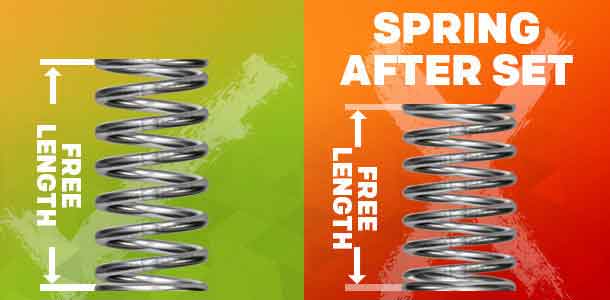Elastic Limit = Maximum Safe Travel
When it comes to springs, the terms “maximum safe travel”. “elastic limit” and “taking a set” can be a little confusing to understand because they are all related. These terms are all related to the importance of respecting the limits of deflection that each spring has.
Springs can only be compressed, extended, or torqued to a certain point before it is too far. Since each spring design is different, it is very important that you know the limits of the specific spring you are using.
The elastic limit of a spring (a.k.a maximum safe travel) is the distance a spring can safely compress, extend or torque. If the spring is pushed past this limit it "takes a set." Elastic Limit and Maximum Safe Travel are synonyms. Therefore both refer to how far a spring can go safely, without suffering damage.
Taking a Set: When Springs are Forced Too Far
Taking a set is when a spring is forced to the point of no return and suffers permanent damage. Once a spring takes a set it will never be the same because it has taken on such a great load that it has affected their structure and won't be able to recuperate their initial free/unloaded length (or torqued position in the case of torsion springs). This happens because it has been compressed, extended or torqued past its limit.
Luckily, humans are a little more resilient and when we break something we heal or undergo surgery. If you pull your finger too hard it can become dislocated, if you bend your arm back too far it can break, but we all have a different elastic limit. Some of us are not flexible at all while other are incredibly flexible and can withstand much more. However, when it comes to springs, there is no turning back, you can’t repair them.

How Far Can Your Spring Go?
Let's say a compression spring's free length is 1 inch and, based on how thick the coils are, you can physically compress it down to the solid height of 0.25 inches. Does this mean you should? Maybe. It depends. If the spring’s maximum safe travel is 0.75 inches it means you can make the spring travel down all the way to 0.25 inches without any problem. However, if the spring’s maximum safe travel is 0.6 inches, you will only be able to safely compress it down to a loaded height of 0.4 inches without it taking a set or taking a set.
Let me put it this way: if you should ignore a spring's maximum safe travel and press down a compression spring past this elastic limit, it might go down, but it would have endured so much pressure that it will take set.
Knowing the Load Your Spring Can Handle
Can your spring handle the load you will place on it? How do you know? The answer is easy. All you need to do is go into our Spring Creator calculator and input the measurements of the spring, it will automatically give you an analysis of the spring. In the analysis, go to the section of “rates and loads” and look at “maximum safe travel considering solid height”. You need to respect this value if you want your spring to work right and have a longer cyclic life.





 Español
Español